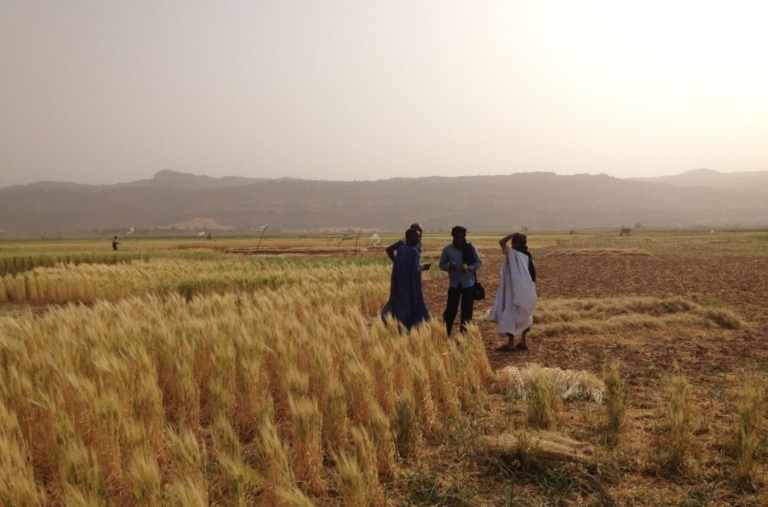For the past four years, I have led an international research team that has made it possible to grow durum wheat in conditions of extreme heat along the Senegal River basin, a region highly affected by poverty. Our scientific breakthrough, essential in the fight against hunger in the region, has won the 2017 Olam Prize for Innovation in Food Security. To find this food solution, we didn’t use GM-breeding. Instead, we relied on advanced breeding techniques applied to strains of primitive and modern wheat to develop a set of durum wheat varieties that can not only withstand constant 35 to 40 degree Celsius (95 to 104 degree Fahrenheit) heat, but also grow remarkably fast, in only 92 days.
This discovery was only possible because, as scientists, we believed in the importance of the past and knew the treasures hidden in these ancient strains. We are certain that more solutions to adapt to the changing climates exist in this ancient gene pool, but these can only be reached if investments continue to flow to support the tedious and never-ending battle of breeding.
It is by no means an easy task, though. First came funding, which is the life blood of the scientific community. In early 2013, our international team of scientists from the International Center for Agricultural Research in the Dry Areas (ICARDA) Morocco, The Swedish University of Agricultural Sciences (SLU Sweden), Senegalese Agricultural Research Institute (ISRA), and CNRADA Mauritania was awarded funds by the Swedish Research Council (U-Forsk2013) to assess durum wheat’s ability to withstand the heat of the Senegal River basin.
For four years our team planted, grew, and watched fail thousands of advanced breeding lines developed by the ICARDA’s breeding program. Yet, among the thousands, a few lines maintained good productivity despite relentless temperatures well above 35 degrees Celsius (95 degrees Fahrenheit) throughout the growing season. Testing continued until we became confident that these lines could indeed be used for production under the harsh conditions of the Senegal River.
But the challenge did not end there. As the Senegal River basin is a major source of rice for West Africa, it would be impossible for farmers to drop this excellent crop in favor of a new and relatively unknown one. Hence, a second selection procedure was initiated to identify only those lines that could go from planting to harvest in less than 100 days—the short time period during which farmers leave their soils uncultivated (fallow) between two rice seasons.
After a few setbacks, the final achievement was to release two ICARDA durum wheat varieties—named Haby and Amina—capable of producing an average of three tons per hectare in just 92 days, a perfect fit for the region. These new varieties hold the potential, once scaled up, to occupy the 200,000 hectares of land currently cultivated with rice to produce 600,000 tons of new food, without impacting the rice harvests.
But how were these varieties developed in the first place? This was due to ICARDA’s commitment to holding one of the world’s largest gene banks for the preservation of historical, primitive, and undomesticated germplasm. This unique germplasm originated before modern agriculture, in some cases dating back thousands of years to the very beginning of agriculture itself, meaning that it has not undergone the process of domestication, and has therefore not been adapted to fit the “simplified environment” that humans have created for their crops through centuries of farming.
This offers scientists a wealth of primitive diversity and useful genes for adaptation to unfavorable climatic conditions. It is worth saying that ICARDA’s gene bank wealth of diversity has been generated through hundreds of missions conducted by international experts in some of the most remote areas of the planet, to collect and preserve these unique plants.
Among these specimens was a primitive emmer (botanical name: Triticum dicoccum) wheat collected in the proximity of Aleppo, Syria. Emmer, known as “farro” in Italy, was first farmed in the Fertile Crescent some 12,000 years ago, but it can still be found in cultivation today in small areas. Similarly, a second important component of this collection is a Syrian accession of goat grass (Ageilops speltoides), an edible weed often used for animal feed. These two primitive strains are at the basis of the varieties released today for the Senegal River.
In fact, both Haby and Amina are the result of crossing made in 2004 of these gene bank accessions with high yielding durum wheat cultivars, followed by breeding selection in Syria, Morocco, and ultimately Mauritania and Senegal. Their unique primitive backbone could ensure in the near future that the bare lands of the winter months along the Senegal River is forever changed into lustrous durum wheat crops, possibly helping lifting a million smallholder farmers’ families out of poverty and famine. Furthermore, these heat-tolerant varieties can be used by breeders around the world to protect the future crops of all countries from the changing climates.
But what would have happened if these primitive strains were not collected? Or if they had been lost to the war raging in Syria? Or if these were not utilized by ICARDA’s breeders? And how much of this powerful diversity have we already lost or will continue to lose around the World? It is unquestionable that our path to a famine-free and sustainable future in spite of the degrading climates will pass through the exploitation by breeders of the treasure troves represented by the gene banks. It is then our responsibility to protect such diversity and promote its use by breeders and farmers.





